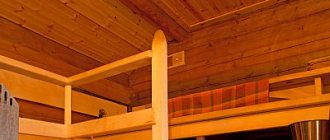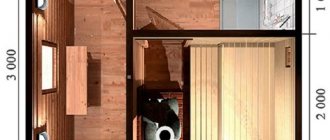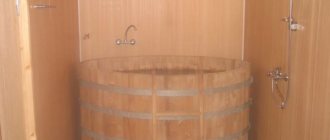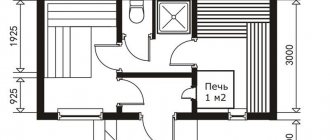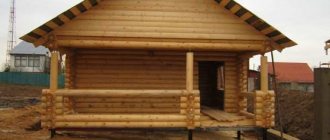A bathhouse is, first of all, a place for comfortable relaxation, so it should have all the amenities. A toilet in a bathhouse is a necessary condition and its creation must be approached carefully and wisely.
If you ignore this question, there will be many situations in the future in which you will regret your decision. It is better, even at the stage of creating the project, to think about where the toilet will be located and how to connect communications to it.
If this point was not taken into account at the construction stage, then you still don’t need to despair - everything can be corrected. In this article we will talk about how to create a toilet in a ready-made bathhouse and how to design it correctly. We will also describe in detail all the nuances of this process, provide a list of necessary materials and give useful advice regarding this issue. We hope that after studying our material you will have no questions or doubts and everything will turn out as well as possible.
If there is already a toilet on the site near the bathhouse, then it is more advisable to leave everything as is
Sewerage layout
The considered sewer elements are connected to each other by a pipe. It is laid in a trench (the diagram is shown in the photo), and always below the freezing level of the soil to ensure year-round operation. A cushion of sand and crushed stone is poured into the trench at the bottom. Currently, plastic sewer pipes have become most popular. They are placed on a cushion with a slope to allow water to flow by gravity. To prevent liquid freezing, it is recommended to insulate pipes using mineral wool or other thermal insulation.
Sewerage in a bathhouse is a necessary and obligatory element of the arrangement and must be carried out in accordance with all the rules. It is entirely possible to do it yourself, but it is necessary to take into account all the recommendations and standards.
Reset organization
Without solving the issue of collecting and disposing of sewage, it is impossible to create a bathroom in a bathhouse. The most reliable and safest in terms of sanitary standards is the construction of stationary septic tanks outside the bathhouse area. They are sealed wells of the required capacity, in which the discharged mass is accumulated and subsequently pumped out by sewer trucks.
In the toilet itself, a standard connection of the toilet bowl to the sewer pipe is provided using standard elements. Next, the pipe is laid in a trench with a slope to ensure gravity flow of liquid (at least 2 mm per meter of length). The depth of its installation must exceed the depth of winter freezing of the soil.
The sewer pipe is connected to a sealed storage tank. A septic tank, as a rule, is made of reinforced concrete well rings with a diameter of 0.9-1.2 m with reliable waterproofing of the joints on the outside. The bottom of the well is filled with concrete 20-30 cm thick and reinforced with steel rods. The top of the septic tank is covered with a concrete slab with a hole for a hatch.
Sewerage diagram for a toilet in a bathhouse with a septic tank and ventilation
When constructing an attached toilet, a cesspool is often used for drainage. The main requirement for it is the tightness of the bottom and walls. It can be made by pouring concrete, from sand-lime brick followed by plaster, in the form of a metal or plastic container. The construction of an attached bathroom begins with digging this hole and arranging it. The advantage of this method is that there is no need to lay sewer pipes.
nuance! When planning storage tanks of any design, it should be remembered that feces tend to decompose, releasing substances harmful to the human body.
To eliminate the risk of poisoning, it is necessary to provide a ventilation duct for the outflow of gases from the storage tanks, and the outlet should be raised above the roof of the bathhouse.
We design a sewerage scheme for a bathhouse
For greater design convenience, the unified sewer system is divided into two types: internal and external. The first includes communications indoors, the second - outside the building. Once you familiarize yourself with the basic principles of constructing a circuit, it is easy to develop it yourself.
Design stages
- It is necessary to draw a plan of the bathhouse, taking into account the thickness of the walls and partitions of the building. Graph paper is best for this purpose, but you can also use a regular piece of checkered paper.
- Indicate the dimensions, mark the installation locations of plumbing fixtures or drain points.
- Determine the location of the main pipe outlet.
- If the bathhouse has a toilet, take into account the need to install a drain pipe.
- Plumbing fixtures are connected to the main pipe along the most convenient and short path, aiming for a minimum number of turns in the line.
- The length of the communications is summed up, taking into account the outlet beyond the outer wall of the bathhouse.
- Proceed to constructing a drawing of the external sewer system.
Rules for designing an external network:
- an inspection hatch is provided at the junction of the external and internal sewerage;
- according to SNiP, inspection wells are installed at the turning points of the main line, at the points of connection of a separate side branch of the pipeline, every 15-35 m of a straight main line with a pipe diameter of 100-150 mm;
- according to SNiP, the slope of external sewerage with a pipe diameter of 110-150 mm is 0.01 (1 cm per 1 meter);
- the first inspection well should be located no closer than 3 m and no further than 12 m from the bathhouse;
- if the site has a large slope and there is a toilet in the room, install a multi-stage sewerage system with drop-off wells.
Using block containers
The use of block containers greatly simplifies the construction of bathhouses with a toilet, shower and utility unit. They include everything you need, including suitable furniture. Block containers for bathhouses are lined with wood inside, and their design corresponds to a classic Russian bathhouse. The entire structure is completely fireproof.
In addition, if necessary, such a bath can be easily transported or moved to another location. All necessary equipment is included in the kit.
Planning is the basis of bathroom design
In theory, the difference between the above schemes for arranging a bathroom in a bathhouse according to the water closet scheme lies in the type and location of the sewer tank. Only if connected to a centralized or local village sewer system, there is no point in installing a storage or recycling sewer tank.
In a simplified, cheap version of organizing a toilet, the role of a sewer storage tank will be played by a primitive cesspool located behind the rear wall of the bathhouse.
If it is decided to build a sewer system for a bath toilet using the most complex, but extremely high-quality method for life, the function of a cesspool will be performed by a factory or home-made septic tank.
It is ideal if future bathhouse owners decide at the design stage whether they need a toilet inside or not. You should choose a place to organize it in the bathhouse in advance, because:
- it is recommended to place the bathroom in the corner of the building so that the two walls of this sanitary and hygienic room coincide with the external walls of the bathhouse;
- You should not choose a place to organize it in the dressing room next to the front door if you plan to receive bath procedures in the winter;
- the cesspool must be at least 20m away from the source of process water;
- the distance between the cesspool or septic tank should be minimal, taking into account the fact that turns of the sewer pipeline should be avoided. Choosing a route with a minimum length will allow you to significantly save on materials;
- external sewerage pipes must be laid with a slope towards the cesspool or septic tank, the approximate size of the slope is 1 cm per linear meter of pipeline.
You also need to calculate in advance the point of passage of the sewerage through the foundation, because when it is poured into the formwork, a sleeve is laid horizontally, the height of which must be higher than the line of laying the external sewer pipeline. Pipes leading to the cesspool should be insulated.
If the sleeve was not placed in the foundation being poured, a hole for the sewer pipe can be made with a hammer or hammer drill, and then the space between the pipe and the foundation can be filled with mortar.
Toilet assembly
There are two ways to build toilets: frame and frameless. Both methods cope with the task perfectly; the work can be done without outside help.
Frame assembly
Initial data. The height of the toilet is 2 m, the width and length are one meter, the roof is pitched, the covering material is metal profile. For the frames, you need 50x50 mm timber, the wall cladding is done with clapboard. Insulation from foam sheets.
Step 1. Assemble frame elements from beams according to the specified dimensions; assembly can be done using screws or nails; to increase the stability of the structure, install metal angles on loaded units.
Front frame
Pedestal frame
Prices for metal profiles
metal profile
Step 2. Connect the prepared elements into a single structure, check its spatial position. All angles must be 90°. Make a sheathing for the roof covering.
Roof
Step 3. Cover the external walls with forced or tongue-and-groove planed boards. If desired, you can make a small window on the back wall.
The photo shows an example of the process of attaching the lining
Prices for lining
lining
Step 4. Install foam sheets on the inside.
Scheme of wall insulation with foam plastic
The thickness of the sheets is approximately two centimeters. You should not use thicker foam; a comfortable temperature in the toilet should only be maintained for a few minutes.
Polystyrene foam 1x1 m, thickness 2 cm, density 35
Insulation with thin sheets copes with this task perfectly. Make sure there are no gaps between the foam and the frame. Adjust each sheet of insulation separately; the dimensions of the sheet should be several millimeters larger than the dimensions of the niches for them. Polystyrene foam can be cut perfectly with a sharp mounting knife.
The insulation can be fixed using ordinary nails of the appropriate length with an increased diameter of the head. Select the length of the nails so that they do not pierce through the outer sheathing boards.
In the photo - how to attach polystyrene foam to the wall
Step 5. On the inside of the toilet, the walls can be sheathed with fiberboard sheets and then wallpapered. If you have time, money and desire, use more expensive materials.
In the photo there is a restroom with wallpaper installed inside.
Step 6. If the toilet has a cesspool, you need to make a pedestal; when using a dry closet, the work is simplified.
Example of a pedestal frame for a pit toilet
Dry toilet and peat bucket
Dry toilet
Step 7. Lay the flooring from boards at least 35 mm thick. Given the small width of the structure, there is no need to install floor joists; the boards can be laid directly on the lower bars of the frame.
Making the floor in the toilet
Step 8: Cover the roof. We offer the simplest and cheapest option - to use a metal profile sheet, but taking into account the general appearance of the bathhouse, you can use any other material.
An example of the stages of constructing a gable roof for a latrine
Example of constructing a flat roof toilet
At this point, the main construction work has been completed. Now you should start heating the toilet. For insulation, you can use an ordinary spiral fan; it has the highest efficiency among all those produced; a small volume of the toilet will warm up in just one or two minutes. It is better to install the heater switch in the bathhouse; before visiting the toilet, the fan is turned on and by the time the visitor approaches it, the room is already warmed up.
Scroll fans
You can also install UV heaters that are fashionable today, but we do not recommend them; their high price does not correspond to their equally high efficiency.
Example of a UFO heater
We also do not recommend installing oil radiators - they are very inert. A sufficient amount of time passes from the moment of switching on until heating begins, this creates significant inconvenience. After switching off, oil radiators continue to heat the room using the accumulated thermal energy, but who needs this if there is no one in the toilet.
Oil radiators
Frameless assembly
The material of manufacture is lining. Two symmetrical grooves should be cut into the lining boards on each side. The length of the grooves should be equal to one third of the width of the lining, the distance between them corresponds to the length and width of the toilet. To improve the appearance, it is recommended to round off the ends. The number of boards depends on their width and height of the toilet.
The walls are assembled according to the principle of a children's construction set; each row should be tapped with a mallet. Make sure that the tongues and grooves of the lining match and are tightly connected. If you don’t have a mallet, seal the joints with an ordinary hammer, placing scraps of board under it. Every five rows, check the position of the walls with a level.
Video – Toilet on the street
Professional advice. If you made a slight mistake when cutting out the grooves and the structure is wobbly, there’s nothing to worry about, reinforce the corners with wooden blocks or metal corners. All the same, the internal walls will have to be insulated with foam plastic; additional structural reinforcement elements will become invisible.
Grooves on boards
Next, insulate the toilet walls from the inside, apply the finishing coating to the walls and connect the heater. The technology for producing these works is no different from that described above.
Stages of building a frameless toilet
Choosing the type of sewer system
To improve the bathhouse, it is possible to use three types of individual sewerage:
- non-pressure;
- pressure;
- connected to a centralized city drainage system or to the existing sewer system of a private house.
Gravity system
Gravity sewerage
The non-pressure method of drainage is otherwise called gravity. This is the simplest and least expensive type of sanitary sewer system. Its main advantage: energy independence. Installation of a free-flow system requires careful adherence to the slope of the pipes (1-1.5 cm per 1 linear meter) and is impossible if the terrain of the site is difficult.
Sewer slope
To transport wastewater, pipes of a larger diameter are required than when installing a pressure system. Straightness of the highway is highly desirable. If the pipeline diagram includes turning points, inspection wells are installed in these places. This rule is relevant for any type of sewer system.
Pressure system
General scheme of pressure sewerage
The pressure sewer system provides for the forced transportation of wastewater, which is provided by a pump or pumping station. The equipment can be installed both indoors and outdoors. A pressure sewerage system for a bathhouse is built if for some reason it is impossible to make a non-pressure one. Features of this type of sewer:
- pressure is more expensive than non-pressure;
- volatile;
- requires insulation of equipment in winter.
Inset sewerage system
A less labor-intensive, but most troublesome way is to connect to a centralized sewer network. This method is not possible for all bathhouse owners. Therefore, it makes no sense to consider it in all details.
Connection to a centralized sewer network
More often, it is used to connect the wastewater system to an existing septic tank on the site. However, in this case, you will have to choose the type of drainage system (pressure or gravity).
Connection to a septic tank
Design Features
A bathhouse with a bathroom requires a special approach to design, because... Already at this stage, issues of not only the placement of the toilet on the plan, but also the supply of water supply, organization of sewerage and ventilation should be worked out. There are many standard bathhouse designs that you can safely use on your site. You can choose options for large buildings: a two-story bathhouse with a bathroom or a design for a bathhouse with a bathroom and an attic. In such structures, a certain problem arises with ventilation. Thus, a bathhouse with an attic and a bathroom requires the passage of a ventilation riser through the living space, which requires its reliable insulation and placement along the edge of the attic.
Figure 2. Project of a 6x6 m bathhouse with a bathroom
Typical popular projects include the following:
- 6x6 bathhouse (the design with a bathroom is shown in Fig. 2);
- a bathhouse made of timber with a toilet (Fig. 3);
- bathhouse with shower and toilet (Fig. 4).
Figure 3. Project of a bathhouse made of timber with a toilet
Figure 4. Design of a bathhouse with shower and toilet
In large buildings, finding a place for a toilet is not difficult
In such projects, it is important to place it optimally relative to other rooms. Naturally, the greatest need for a bathroom arises after a bath procedure during a period of relaxation in the relaxation room, which must be taken into account
However, the use of the establishment should not interfere with other vacationers.
It is somewhat more difficult to allocate space in small buildings, but standard options are provided for them as well. Thus, 4x5 bathhouse projects with a bathroom and even a 2x6 bathhouse project with a small bathroom are available for implementation. In small bathhouses, mobile options are more often installed, especially when the desire to increase comfort arose after several years of their operation.
”
A bathhouse with a bathroom is not only a tribute to fashion and prestige. With frequent and year-round bathing procedures, organizing such convenience becomes a necessity. The desire for such a little comfort arises especially acutely when there is a rest room, and also when there are small children in the family. It is best to plan a toilet inside a bathhouse at the design stage, but the problem can be solved in an existing establishment.
Why problems arise
First of all, you need to decide whether a bathroom is needed in the bathhouse. Maybe it’s easier to run to an existing toilet if necessary? This issue must be resolved taking into account all the features of the bathhouse itself and its comfort.
Advice! If a stationary toilet is located very close to the bathhouse or it is used quite rarely, then it is not advisable to place the bathroom inside. The same can be said if there is a very small bathhouse in which there is no rest room.
In most cases, the need for a toilet inside a bathhouse is quite urgent. As a rule, private areas are fenced off with an openwork or mesh fence, which does not allow you to run to the toilet undressed, and getting dressed and undressing spoils the entire bathing procedure. If the bathhouse is used in the cold season, then it is generally difficult to do without a warm internal toilet, especially during a leisurely process with relaxation in the relaxation room. The relevance of such an institution is dictated by the presence of children. They definitely shouldn’t be allowed out into the street when they’re hot. Finally, the design of a bathhouse with a bathroom is about providing comfort and increasing prestige, when you are not ashamed to invite friends to take a steam bath in the bathhouse.
The bathroom is more suitable for a large bath or sauna with a relaxation room
What is the problem with placing a toilet in a bathhouse? The following circumstances can be highlighted:
- The need for a completely isolated area. Even taking into account the small dimensions of the bathroom, it is quite difficult to find additional space in a small bathhouse.
- Increased requirements for sewerage discharge. While wastewater from a bathhouse can be discharged into the soil through drainage wells, this cannot be done with toilet sewage. Feces must not be collected in pits or transported through chutes. They should be immediately collected in storage tanks or discharged outside through pipes. In this case, hydraulic locks are required that can eliminate odor.
- Ventilation. The role of ventilation is increasing, and in the bathroom it should have a forced exhaust character.
- Isolation. Water vapor should not penetrate into the toilet, which will condense on the structural elements. In addition, increased air temperature is also undesirable, because This all stimulates the spread of odors.
It is necessary to carefully consider the sewerage and drainage system in the bathhouse
Drain or sewer
Another fundamental point for installing a toilet is draining wastewater, that is, organizing a sewer system.
If it is possible to connect to the network sewer, then this is very good
In the bathhouse itself, in the toilet, you need to install a pipe to which the toilet will subsequently be connected. To do this, you need to accurately determine its location and prepare the space for work. The fact is that simply running the pipe through a wooden floor will be wrong, as this will create a danger of the floor rotting and the spread of dampness. Therefore, it is better to at least lay the floor in the toilet area with ceramic tiles - make a square of 60 by 60 cm, but it would be more practical to lay the entire floor with tiles. But this is already finishing, and we are talking about drainage.
So, you need to cut a round hole in the floor, the diameter of which should be slightly larger than the diameter of the pipe. Lay a metal mesh on the floor equal in size to the planned tiles (60x60 cm or over the entire floor), the mesh must be shot to the floor with a construction stapler. After this, you need to prepare a concrete solution according to the following formula:
1 part water + 2 parts sand + 1 part cement
You will need a little solution at this stage, so do not overdo it. Now you need to carefully cement the prepared space and let it dry. At the same time, it is necessary to remove the drain pipe and secure it in the hole with a solution, this will ensure the reliability of the structure and prevent the spread of a damp environment. All this work will take about a couple of days to dry. The diameter of the pipe for the sewer outlet is usually 100 mm; this diameter is considered optimal for a toilet. Next, from the bathhouse the pipe is laid directly to the drainage point. If it is a sewer, then the pipe is connected directly to the main line. But if you decide to make a separate pit, then you need to say more about it. To finish the conversation about the pipe, it should be noted that the drain pipe must always run at a slight slope along its entire length. It should be buried approximately 50-60 cm into the ground, depending on the climate in which you live.
It is better not to leave the drained sewer next to the tree, but to concrete the floor around it
Water supply
If you have already decided on the location and know exactly where the toilet and plumbing will be located in it, then you need to think about how to supply water to this location. This must be done at a stage when plumbing has not been installed and finishing work has not been carried out. If the bathhouse already has a shower, then the problem is reduced and you will only need to redistribute the water supply from this room. But if there is no water in the bathhouse at all, then there will be more worries.
The first thing that needs to be decided at this stage is how the bathhouse will be used in the winter. If you rarely visit it or it is located in a country house where no one lives, then the water will have to be drained from the system in cold weather. Otherwise, the water in the system will freeze and the entire structure will become unusable. If you don’t want to drain the water, or the bathhouse is located near the house, then you need to think about the heating system. In large baths, which are often used and in which a lot of time is spent, traditionally, a classic heating system is installed.
If there is no heating in your bathhouse, then you can simply insulate the water supply pipes; for this, special insulating sleeves are put on them at the installation stage. They are sold today in any hardware store. Of course, you can wrap the pipes with insulation and fix it, but this is very labor-intensive. In addition, special couplings will not only protect the pipe from freezing, but also prevent the formation of condensation. Therefore, there is no point in experimenting, especially since such couplings are very inexpensive.
It is most convenient to add water to the bathhouse toilet during the construction stage
The installation of a water supply must be approached responsibly and carefully, since the entire operation of the bathhouse will depend on the quality of the water supply. For water supply to the bathhouse, you need to use a plastic pipe with a diameter of 3-4 cm. When purchasing the necessary materials, you also need to purchase plastic corners and fittings that will be needed to connect the system. The plastic water supply system is connected using a special pipe soldering iron, so if you don't have one, it's worth thinking about where to get one.
Mobile dry toilets
A more fashionable name is powder-closet (dry toilet). Does not require any construction work, no water supply or cesspool required. The body's waste products are collected in sealed containers with peat, and the contents are removed as they are filled. Where? Question. You can’t throw it into a flowerbed, as the manufacturers advertise; you’ll have to dig a separate hole each time or build a large storage tank. And if it’s winter, how to dig holes on the site?
Peat dry toilets
But this is not all the problems that arise when using dry closets. Can you imagine a relaxation room in a bathhouse or dressing room, in the corner of which there is a dry closet? No? And we can't. In this regard, we strongly do not recommend purchasing such devices and do not believe the manufacturers’ advertising brochures. You can take these toilets with you when you go on a picnic. And then only if you are a very well-mannered person, you don’t throw anything away in the forest and you bring all the waste to your dacha and bury it in the garden bed.
Peat dry toilet
Disposal of peat from a dry closet
Construction stages
The construction of a bathroom occurs in several stages:
- Determining the type of toilet and method of drainage.
- Choosing a location, drawing up a toilet project.
- Laying sewerage in accordance with technological features.
- Installing a toilet, connecting the sewer pipe to the toilet.
- Interior arrangement.
- Selecting the type of ventilation, location and installation.
The final stage will be finishing. It is better to use ceramic tiles - they are resistant to moisture and do not change appearance when exposed to household chemicals.
A correctly installed toilet increases comfort when taking bath procedures, but when installing it it is important to follow the technology
Design Features
To avoid the need to rebuild and remodel the bath room, the initial stage should be designing a steam room. The finished project will give you the opportunity to decide on the purchase of materials and necessary goods, this will save your time and money. You need to choose the right place on the site to locate the steam room with adjacent rooms.
When choosing a location, you need to know a number of important points:
- places where groundwater passes close to the surface are excluded;
- if you manage to place the steam room on a hill, then the problem of draining dirty water will be solved naturally;
- the bathhouse should be located at a great distance from other buildings, the distance from the country house should be at least eight meters, and about 5 meters to the well;
- if there is a lake or reservoir nearby, then it is advisable to build a bathhouse at a distance of 10-15 meters from the shore, which will eliminate the need to build a pool (any nearby body of water will solve the problem of water supply);
- the entrance to the bathhouse should be located from the south, so that during the cold season, snowdrifts do not block the door;
Determining the location
Previously, bathhouses were built mainly without a toilet, since the toilet was located in the yard and everyone used it. There were no toilets in the houses either - they considered it something unnecessary. But modern man has become accustomed to comfort in everything and is no longer ready to put up with inconvenience even when visiting his own bathhouse. Therefore, installing a bathroom in a bathhouse is very relevant and in demand. The main nuance in this matter is the fact that the bathhouse, as a rule, is small in size, and it is not easy to allocate a space in it even measuring one meter by one meter.
In addition, the bathhouse is finished with natural wood and the building itself is also often built from wooden logs, so the owners fear that it will be difficult to organize ventilation. After all, wooden surfaces absorb odors very strongly, and the toilet can ruin any vacation. But not everything is so simple here. If you choose the right location for the toilet and comply with all the technology requirements, the result will be quite reliable and acceptable.
So, the toilet must be located so that the entrance to it is not visible from the rest room; it is better to organize such a “nook”. This will not only avoid drawing unnecessary attention to such a delicate issue, but also possible odors will linger. Also, when choosing a place for a toilet, you need to take into account the location of the sewer pipe or septic tank on your site, since you will have to drain the drain exactly there and the shorter the distance, the lower the costs.
It is also worth saying a few words in favor of completely abandoning the toilet in the bathhouse, because such an opinion is quite common and even occurs more often than a decision in favor of comfort. So, a toilet in a bathhouse will lead to the following inconveniences:
- The area of the building will have to be increased or the size of the internal premises reduced.
- You will have to install a separate cesspool or obtain permission to tap into the sewer.
- It will be necessary to supply water to the building and organize its safety in the winter, when the bathhouse is rarely used.
- Purchase of plumbing and finishing costs.
But if all these problems don’t scare you, then let’s move on to the immediate description of the work.
The toilet in the bathhouse should be located so that it does not attract unnecessary attention.
Interior items in the washing room
The ease of use of a shower in a bathhouse depends on the equipment of the room. The room has hooks for clothes and cabinets for detergents. Shelves for storing textiles are often made of wood. Models made of strong plexiglass will help to keep the space optically uncluttered.
Furniture in the roomSource irkutsk.zoon.ru
Instead of traditional benches, compact chairs can be placed along the walls. Wooden sun loungers look impressive, next to which there are cabinets on wheels. The size of the table depends on the washing parameters in the bathhouse. In a large space, a massive table is appropriate; in a small space, a folding model or a bar counter is appropriate.
Arrangement of a washing roomSource izhbani.ru
The washbasin is not a mandatory element of the interior. If the size of the room is limited, then the functions of the sink are taken over by the shower in the bathhouse. Near one of the walls you can place a tall narrow cabinet on which you place a tub of water. Shelves with household chemicals are installed nearby.
A shower cabin is a convenient and practical option, which is often used in a bathhouse. Closed models with swinging doors are easy to place in a spacious washroom. Strong acrylic glass can be traditionally transparent or with a smoke effect (matte). In a compact room, designers recommend options with sliding doors (accordion).
Closed cabinSource dizainexpert.ru
If the shower in the bathhouse is needed only for washing, then open models are used. The design consists of a wall-mounted mixer and a tray. Based on the type of material, there are 5 types of bowls:
- Enameled. The steel is coated with a thin protective layer against destruction. Plumbing is very easy and inexpensive. Strong water pressure causes iron to rattle, and minor damage leads to rust.
- Ceramic. Beautiful, elegant earthenware models will harmoniously fit into the interior of a shower room in a bathhouse.
- Cast iron. The surface of heavy pallets is covered with a layer of enamel. Due to their weight, the structures are difficult to install, but durable.
- Acrylic. To prevent a light shower in a bathhouse from bending under the weight of a person, it is placed on supporting legs during installation.
- Marble. Beautiful, decorative elements are very expensive.
Shower bowlSource strojudacha.ru
A mirror is often used to visually change a space. The irregular shape of a washing area in a bathhouse can be easily transformed with reflective surfaces. If there are no windows, then a decorative element with lighting and curtains will replace the glass block.
Types of structures
It is considered convenient to connect to a centralized backbone network integrated with the home system. If this option is not available, there are 4 solutions for draining the liquid:
- Drainage well. The model is suitable for a small washing room in a bathhouse. The “cushion”-based design will ensure natural drainage of water into the ground.
- Storage tank. The wastewater enters a special tank that must be pumped out.
- Cesspool. The underground structure is placed at a distance of 2.5 m from buildings (residential, technical and bathhouses). Dimensions are calculated based on the number of people who will use the steam room.
- Septic tank. Sewers come in single- and double-chamber types and operate on the principle of a cleaning well. The role of a reservoir is played by barrels or containers without a bottom. Crushed stone with sand is used as a filter.
When installing a shower drain in a bathhouse, pay attention to the location of groundwater. If the distance is close, the volume of the chamber is increased, otherwise the drains will not fit inside the structure
It is recommended to install a drainage pit and a septic tank in sandy soil. In clay species, moisture stagnates.
Arrangement of the utility block
The utility block allows you to make a bathhouse not just a bathhouse, but a building where you can also cook food, receive guests, and relax. This allows you to free up a significant part of the residential building and use a separate room for economic purposes.
Of course, the design of a bathhouse with a utility block should differ in the following parameters:
- convenient entrances to the premises;
- good water supply;
- heat exchange networks;
- security measures.
It is worth paying special attention to the last point, since you may need to use both the bathhouse and the utility unit at the same time. Therefore, safety rules must be followed. Good thermal insulation of the room, ventilation system and the use of moisture-resistant materials are also important here.
Installing a stove in a bathhouse
The last item on our list, but not the least important, will be installing a stove in the bathhouse. There is a separate article on the website about choosing sauna stoves and calculating their power.
Here we will dwell more on the process of installing a stove in a bathhouse. It would be good if a separate foundation was equipped for the sauna stove. It can be connected to the general foundation of the bathhouse, if it is capital. And you should not connect the stove foundation with the general one if the bathhouse is built on a small strip or on block pillars.
After purchase, a cast iron or steel stove should be heated outside 1-2 times - this will burn off all the factory dirt that is in any sauna stove after production.
The sauna stove should first be heated - “burned out” - outside, and only then installed in its place in the sauna.
Only after this is it worth installing the sauna stove in its rightful place in the steam room. And only after this can you pull the chimney up and cut a hole in the roof for the pipe. If you do this in advance, you may make a mistake. Sometimes you see a closed hole in the roof next to a pipe - the result of hasty actions by the owner.
Installing a stove in a bathhouse
Here we will dwell more on the process of installing a stove in a bathhouse. It would be good if a separate foundation was equipped for the sauna stove. It can be connected to the general foundation of the bathhouse, if it is capital. And you should not connect the stove foundation with the general one if the bathhouse is built on a small strip or on block pillars.
After purchase, a cast iron or steel stove should be heated outside 1-2 times - this will burn off all the factory dirt that is in any sauna stove after production.
The sauna stove should first be heated - “burned out” - outside, and only then installed in its place in the sauna.
Only after this is it worth installing the sauna stove in its rightful place in the steam room. And only after this can you pull the chimney up and cut a hole in the roof for the pipe. If you do this in advance, you may make a mistake. Sometimes you see a closed hole in the roof next to a pipe - the result of hasty actions by the owner.
What to consider?
When building a bathhouse, you need to take into account many nuances. The building must be located on the site at a distance from other structures. You cannot install a bathhouse close to a fence, and you also need to take into account that it is located without disturbing the neighbors. Otherwise, problems are possible that will entail fines and dismantling of the bathhouse.
If possible, it is better to install such a structure in a quiet place, away from the road, surrounded by greenery. It's great if there is a body of water nearby. It is worth considering in advance the installation of all communications. The area should be level, clean, with dense soil. If there are no such conditions, then the surface needs to be prepared: cleared, leveled.
There are many options: wood (logs, timber), various blocks (foam concrete, aerated concrete), brick. When choosing a material, you need to focus on its price, durability, aesthetic and performance qualities. And, of course, the structure must correspond to the general style of the entire site. It is advisable to build a bathhouse from the same material as the main house.
Classification
All bath toilets can be divided into 3 groups: outdoor attached, mobile and stationary. The choice of a particular option depends on many conditions: architectural nuances, climate, financial capabilities, personal preferences.
Outdoor attached
An attached outdoor toilet is a traditional option that has been used for a long time as the only correct one. And although modern doctors strongly do not recommend its installation, many bathhouse owners are still installing it. And this is not surprising, because such designs have a number of advantages:
- They can be built at any time, both at the stage of assembling the log house and during the operation of the bathhouse;
- Eliminates the possibility of unpleasant odors forming;
- The internal area of the premises is preserved;
- The entrance to the toilet can be made from two sides;
- There is no need to empty utility networks for the winter;
- You can choose any size and design.
Modern technologies make it possible to equip such a toilet quickly and cheaply. And to ensure a comfortable microclimate, an economical heater is installed.
Why do you need a project and how to choose it
Not only Russians love to take a steam bath, which is not even a place for ablution, but a place for cleansing and rejuvenating the body. That’s why there are many types of them. There are Scandinavian saunas that are very hot because they have almost no steam; there are Japanese ofuro baths, which instead of a steam room have a spacious plunge pool with hot water; There are Turkish hammams that are maximally saturated with moisture, but at a low temperature.
Russian baths are damp, since the heat effect in them is obtained not due to extreme heating, but due to hot steam. The operating mode also affects the selection of building materials, internal and external cladding, and heating methods.
Traditional Russian bath
- The project must take all this into account. And who will implement it - a hired team or you yourself, it doesn’t make much difference. The main thing is to choose the right place for the building, which should be located on the leeward side and preferably not in a lowland.
- A suitable place is when the steam room can be placed near a natural body of water to plunge from the steam room into cold water. But not everyone is so lucky, so many people build an artificial pond next to the bathhouse - if not for swimming, then for pleasant contemplation (read on our website: how to make a beautiful pond in your dacha).
- In general, to make the construction comfortable, you need to take into account many nuances. One of them is the choice of a project that takes into account the number of people using the steam room and provides for passive relaxation. Therefore, not just bathhouses are often designed, but holiday homes with a sauna and other amenities.
Space under the stairs
A small niche under the stairs cannot always be used to create a toilet. The choice of its arrangement directly depends on the size. Some owners prefer to make a bathroom out of it. You can also put a washing machine or dishwasher in the pantry. However, you will first need to equip the room with water or a centralized drain.
If this is not possible, then the space can be used for the following purposes:
- Storage space.
- Workshop.
- Room for a pet.
- Cabinet.
- Dressing room for storing wardrobe.
- Seating area with bed.
Greenhouse under the stairs
Open seating area under the stairs
Wardrobe under the stairs
Small sofa under the stairs
Minibar and kitchen sink under the stairs
Water seal options
A water seal is an important element of the sewer system, the purpose of which is to cut off unpleasant odors coming from the septic tank (drainage pit). Simply put, this is a water plug that remains in the pipe even if the bathhouse is not in use. An example of the simplest water seal is a U-shaped siphon. In a pipeline made of plastic pipes, a water plug is created using three shaped elements: bends.
The difficulty is that when the sewer system is rarely used, the water in the water seal tends to evaporate. In this case, experts recommend installing a dry shutter. It is a simple plastic or metal structure equipped with a spring and a valve (membrane) that blocks the exit from the pipe. When water enters the system, the damper is folded back under its pressure, and after the flow passes, it returns to its place.
Craftsmen make unique homemade valve systems for bath drains. If you wish, you can use one of the following options.
| System Description | Illustration |
| A plastic funnel with a diameter slightly larger than the cross-section of the pipe and an outlet with a diameter of 3 cm is installed in a vertical position into the gap in the sewer pipe. A plastic ball (for ping-pong or other) is placed in the funnel of such a size that it blocks the narrow exit. When water gets into the pipe, the ball floats up. | A funnel and ball valve. Example for clarity |
| To install a dry seal for a plastic sewer with a pipe diameter of 50 mm, you will need a 50/110 adapter, which needs to be slightly modified: cut at an angle and attach a circle of thick rubber to it. After which the structure is installed at the outlet of the pipe in a septic tank or drainage pit. | Dry shutter Dry seal in the sewer pit |
Installing a stove in a bathhouse
Here we will dwell more on the process of installing a stove in a bathhouse. It would be good if a separate foundation was equipped for the sauna stove. It can be connected to the general foundation of the bathhouse, if it is capital. And you should not connect the stove foundation with the general one if the bathhouse is built on a small strip or on block pillars.
After purchase, a cast iron or steel stove should be heated outside 1-2 times - this will burn off all the factory dirt that is in any sauna stove after production.
The sauna stove should first be heated - “burned out” - outside, and only then installed in its place in the sauna.
Only after this is it worth installing the sauna stove in its rightful place in the steam room. And only after this can you pull the chimney up and cut a hole in the roof for the pipe. If you do this in advance, you may make a mistake. Sometimes you see a closed hole in the roof next to a pipe - the result of hasty actions by the owner.

